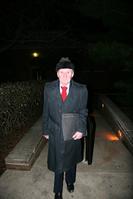Les Geddes Featured In Impact
AROUND THE FOUNTAIN
Les Geddes arrives at work. At age 85, the Showalter Distinguished Professor Emeritus of Biomedical Engineering is developing better equipment for performing CPRand getting more done before daybreak than the rest of us do before dinner.
March 2, 2006 4:26 a.m. Northeast entrance, Potter Engineering Center
Tell us a little about yourself. I was born in Scotland and educated in Canada and Texas. I went to McGill University and earned two degrees in engineering and a doctorate in science, and a PhD in physiology and pharmacology from Baylor Medical College. I was seduced to Purdue in 1974 from Baylor [to start up a biomedical engineering program] and have been here ever since as the Showalter Distinguished Professor, now emeritus. I had to retire in 1991 from my administrative position [as head of Purdue's Hillenbrand Biomedical Engineering Center]but I am still teaching and doing research, and enjoying life.
What are you planning to work on this morning? I'm working on some research relating to improving the outcome of CPR, and I'm preparing to contest this afternoon how the NIH reviewed some of my grant applications.
What were conditions like at Purdue 30 years ago? They gave me a quarter of a million dollars to start biomedical engineering, and said, "That's all you're going to get." So we immediately had to figure out how to get money to support these people [colleagues who came with him from Baylor] and do research. We started writing grant applications to NIH, NSF, and industry. We went after contract work, and we did very well. I was criticized very, very severely by engineering faculty. They thought that when you're doing business with industry, that's not research but technologythat's dirty stuff. The same critics later said [in defense of such research], "Well, industry is asking more sophisticated questions now."
How have Purdue and BME changed since you arrived in 1974? In 1974, biomedical engineering was a center, and the students earned their degree from their parent school. It was only in the last seven or eight years, with the arrival of the biomedical engineering department [now the Weldon School of Biomedical Engineering], that degrees came to be awarded in biomedical engineering.
What are your three greatest research accomplishments? First, the work we did in ventricular defibrillation. There are three "laws," and we discovered two of them. The next one is the small intestine submucosa, the extracellular matrix that if you implant it becomes host tissue. The third one is the work we did on implantable automatic defibrillators. It's not all one personwe work as a team.
Any research being commercialized? My research at present is cardiopulmonary resuscitation, and you may not know how bad that situation is. For every minute delay, your chances of being resuscitated go down 10 percent. The problem is, there is no sign or signal to tell you when you are pushing hard enough on the chest. It takes more than 100 pounds of force to get the compression called for, and none of the 84 trained rescuers we tested could push more than 100 pounds. The situation is that they are not pushing enough, and new guidelines call for harder and faster. We have developed a method that gives you immediate feedback on the efficacy of your chest compressionshow well you are doingto help improve CPR.
What's a typical day for you? I come in at 4:30 in the morning and look at e-mail from the previous day. I am most creative in the morning, so I write grant applications and papers, and then at 6 o'clock I take a break and walk around campus for about half an hour. Then I work and I can get a day's work in by 9, when people find me. The rest of the day is putting out brushfires, and I leave about 10:30 or 11 and then practice my other trade as an expert witness.
What's next for you? Keep alive! To be able to keep on doing what I'm doing. If I couldn't be an engineer, I wouldn't know what else I would do.

